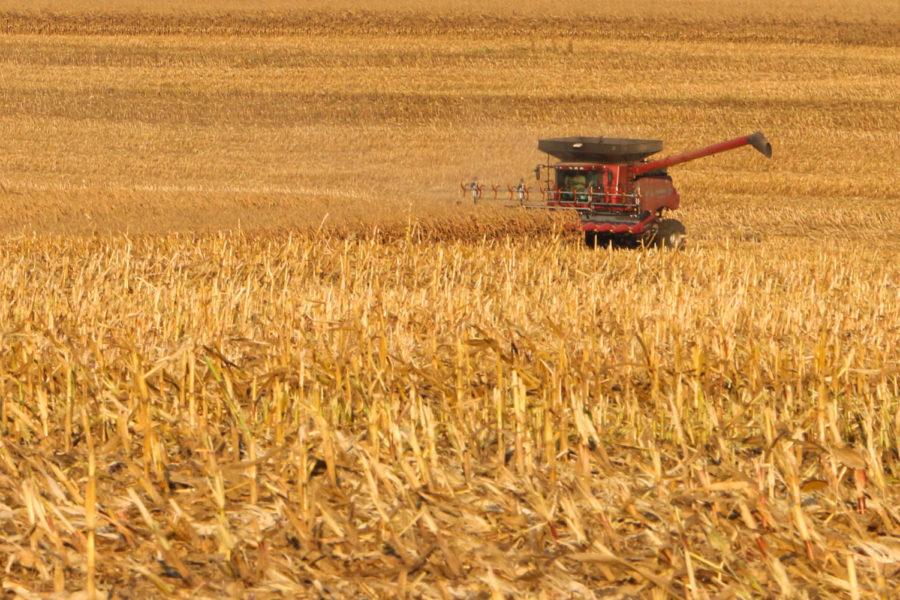Seminar discusses shifts in the US Corn Belt
Emily Blobaum/Iowa State Daily
A combine harvests corn on Saturday, Oct. 21. The Heinemans own 900 acres of land, which takes several weeks to complete harvesting.
February 7, 2018
The highest yields of corn production in the United States come from the Corn Belt, a stretch of states that spans the majority of the Midwest. Eric Hunt has been researching this area since 1961 and found that the area we classify as the Corn Belt has been moving Northwest.
This spatial issue of the Corn Belt was discussed in his lecture titled “Yield Trends and Shifts in the U.S. Corn Belt.” This lecture was a part of the Spring Soil Science Seminar Series.
Dr. Hunt received his Bachelor of Science degree in meteorology at the University of Oklahoma in 2005. He then received his master’s degree and doctorate in natural resource sciences at the University of Nebraska-Lincoln.
Since 2012, he has been working at Atmospheric and Environmental Research Inc. Additionally, he is an adjunct faculty member of the School of Natural Resources at the University of Nebraska-Lincoln.
The main purpose of his seminar was to discuss the methodology behind his report on corn yields in the Corn Belt that was published last fall.
He collected data from 1961-2016 from 60 different crop reporting districts stretching from North Dakota to Kansas and from Nebraska to Ohio. However, in some cases in the report, the data refers to 66 total districts. This is because he differentiates the districts in Nebraska between irrigated and rain fed.
All of the districts were ranked by their corn yield within a specific time frame. The districts with the higher yields were given a higher number, where the ones that had a weaker performance would be given a higher one.
So the district with the highest yield for that time period would be given a one and the lowest would be given around 60.
In the early phases of the research, Illinois, Indiana and Iowa were always at the top of the ranks. Illinois and Iowa took turns being first in production. Over time however, Indiana began to slip while places like Minnesota and northeast Nebraska moved up.
Today, districts in Minnesota have increased so much they have shown better results than districts in Illinois.
“The good news is with the exception of south, central and maybe southeast Iowa, most of the districts here, even if they have fallen off a little bit, haven’t fallen off by nearly as much as you’ve seen in eastern Illinois into Indiana and southern Illinois,” Hunt said.
Iowa has always been around the top. Looking ahead, there are really no signs of Iowa not being the number one producing state in terms of highest overall yields by distance, Hunt said.
At the beginning of his research, the geographic mean of the corn production in the United States was located in Illinois. As time went on, it moved closer to the Quad Cities, and today it now resides around the Mount Pleasant area.
This shows the mean has shifted about 150 miles toward the northwest in the last 60 years, Hunt said.
“The area that you would probably call the traditional Corn Belt should really now start to include eastern South Dakota and southeast North Dakota,” Hunt said.
Hunt also added places like northeastern Nebraska should be seen as a pretty viable area.
When looking at what makes a Corn Belt county, Hunt says around 80 percent of a harvested cropland is in corn and soybean production.
People mainly talk about the “I States” when referring to corn production—Illinois, Iowa and Indiana. But Hunt thinks today they should be talking about the “I-M states”—Illinois, Iowa and Minnesota.
“I think Indiana is becoming less prominent and with climate change and other factors, I don’t see Indiana ever really gaining that back,” Hunt said.
Looking ahead, Hunt said he is looking at what was really driving these changes over time. The report last year mainly focused on the changes in yield, and they want to research the attributing causes.
He hypothesizes that several factors such as genetics, climate change policy and cultural practices will be key aspects, but they want to further research to find the top three factors that have caused this northwestern shift.







